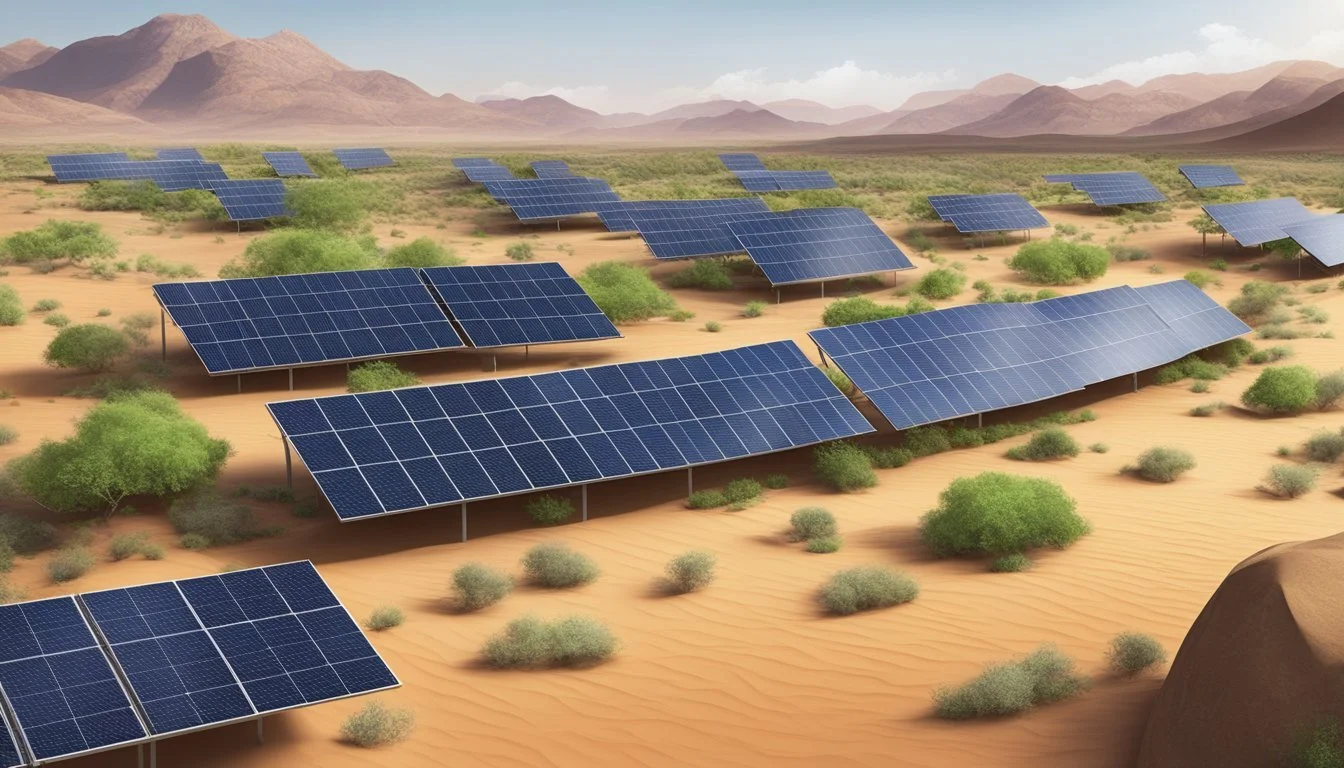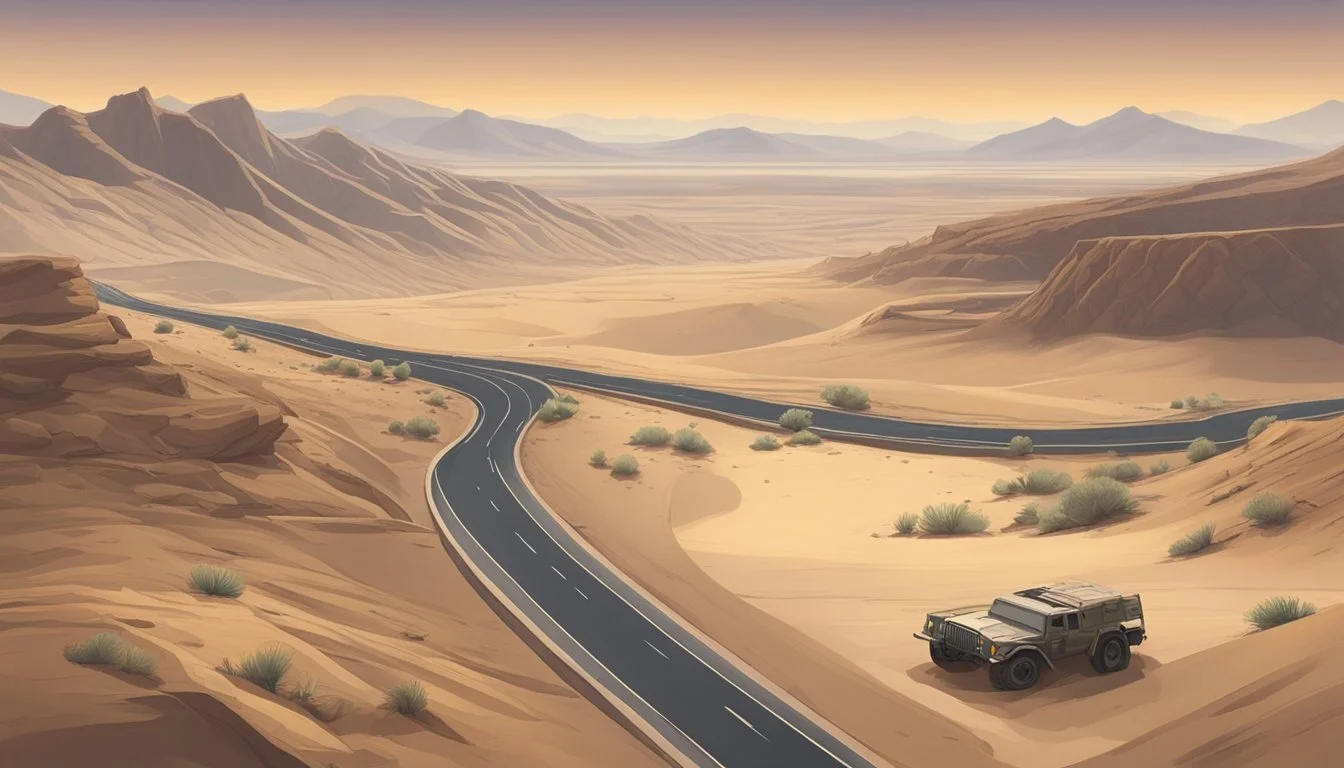Free Land in the Desert
Exploring Viability and Obstacles
Deserts, known for their harsh climates and expansive landscapes, often present a juxtaposition of challenges and opportunities. As populations grow and urban areas become increasingly crowded, many individuals and organizations are turning their attention to the vast stretches of free land available in deserts. These areas promise to be frontiers for sustainable and off-grid living, attracting those yearning for self-sufficiency and a connection with nature.
From the Sahara in North Africa to the Mojave in the United States, desert regions provide unique settings for new lifestyle experiments. Deserts such as the High Desert Free Land offer a chance to develop land projects focused on survival and self-sufficiency. Supported by initiatives like the High Desert Institute, these projects prioritize sustainability and resourcefulness amid challenging conditions.
Developments in desert regions also bring into focus critical environmental and conservation issues. For instance, the expansion of human activities in areas like the Mojave Desert has led to significant changes in land use and conservation values. These shifts highlight the delicate balance required to harness the potential of desert lands while safeguarding their ecosystems. ê
Historical Background of Desert Land Allocation
This section covers the origins of free land distribution, the transformation of desert areas into potential assets, and the historical context of significant deserts. Recognizing these aspects provides insights into the complexities and legacies of desert land allocation efforts.
The Origins of Free Land Distribution
Free land distribution in deserts can be traced back to various land reclamation policies and governmental strategies. In North Africa, countries like Tunisia, Algeria, and Morocco initiated policies aimed at transforming desert regions into productive lands. These efforts often involved granting land to large-scale private investors as well as small-scale farmers.
In the mid-20th century, several programs were launched to address food security and unemployment. The Egyptian government, for instance, reclaimed parts of the Sahara Desert to expand agricultural production. The National Park Service and Bureau of Land Management in the United States also played crucial roles in managing and distributing desert lands, albeit for different purposes.
Overall, these strategies were driven by the goal of utilizing barren lands for economic and socio-political benefits.
From Desert Wastelands to Potential Assets
The transformation of deserts from perceived wastelands to valuable assets has been marked by significant agricultural and infrastructural projects. In Egypt, projects in the Nile Delta region aimed to convert desert lands into fertile agricultural fields. Through irrigation technology and land development policies, formerly unproductive areas became key contributors to the national economy.
In North Africa, similar projects have been undertaken to harness the potential of the Sahara Desert. These include integrating crop and livestock systems and promoting exports. Countries like Morocco and Tunisia invested in irrigation infrastructure to support these transformations.
Such initiatives have also been supported by international organizations, highlighting the global interest in desert reclamation. These projects often emphasize sustainability and environmental considerations, aiming to balance development with ecological preservation.
Significant Deserts in Historical Context
Deserts like the Sahara in North Africa hold significant historical and economic importance. Across Tunisia, Algeria, and Morocco, the Sahara has been a central focus of numerous land reclamation programs. These efforts date back to colonial times when European powers sought to exploit the resources and strategic advantages of these regions.
The Sahara's vast expanse presented both opportunities and challenges for land acquisition and development. Each country has approached desert land reclamation with unique strategies that reflect their specific national priorities.
Internationally, the Sahara has been a site of interest for energy projects, including solar farms, which aim to tap into its abundant sunlight. Desert land allocation policies have thus evolved to reflect changing technological and environmental landscapes, making these regions central to contemporary development discussions.
The Ecological Profile of Deserts
Deserts are unique ecosystems characterized by their extreme aridity and fascinating biodiversity. They present myriad environmental challenges and opportunities, greatly influenced by climate change and human activities.
Climate and Weather Patterns
Deserts experience extreme temperatures. Daytime heat can often exceed 113°F (45°C), while nights can be significantly colder. Rainfall is rare, typically less than 10 inches annually, leading to issues like desertification.
Wind patterns create stunning formations like sand dunes and shape the landscape. Some deserts, like the Sahara, are known for their vast stretches of sand. Others, like the Mojave, feature rocky mountains. Factors like geography and altitude further influence desert climates.
Life in Aridity: Flora and Fauna Diversity
Desert flora and fauna have adapted to harsh conditions. Plants like cacti and succulents store water, while deep-rooted shrubs access underground moisture. These plants aid soil conservation.
Animal life is equally diverse. Creatures such as fennec foxes, camels, and scorpions have evolved unique survival strategies. Nocturnal habits and specialized diets are common adaptations.
Species distribution varies with microclimates. Oasis regions support more complex ecosystems, often with lakes or rivers providing crucial water sources.
Desertification and Environmental Concerns
Desertification is a significant environmental issue. It involves the degradation of once fertile land into desert, primarily due to climate change and unsustainable practices. Overgrazing, deforestation, and poor water management exacerbate this problem.
The impact is severe, leading to loss of biodiversity and increased sand and dust storms. Efforts like soil conservation, sustainable land management, and reforestation are vital to combat desertification and restore ecosystems.
In summary, deserts are ecosystems of contrast and resilience, facing both natural and anthropogenic challenges that shape their unique environments.
Legal Framework and Land Rights
Understanding the legal framework surrounding land rights in desert areas involves examining free land policies and the role of government and regulatory agencies. This exploration highlights the complexities and implications for stakeholders.
Understanding Free Land Policies
Free land policies aim to allocate land without cost to promote economic development and settlement. These policies often vary by region and can be influenced by national priorities and legislation.
In some regions, policies may prioritize attracting foreign investors with promises of land, creating potential conflicts with local customary land rights. Despite intentions to boost regional development, these policies can lead to misunderstandings and disputes over rightful ownership and use.
Clear definitions and robust legal structures are critical to mitigate conflicts and ensure sustainable development. Legal clarity is essential to balance the interests of local communities, indigenous peoples, and investors.
The Role of Government and Regulatory Agencies
Government bodies and regulatory agencies play a crucial role in overseeing land distribution and enforcement of land rights. They ensure that policies are implemented fairly and benefit all stakeholders involved.
Regulatory agencies must handle the registration and titling of land efficiently. This includes demarcating lands, recognizing indigenous and community rights, and managing disputes.
Governments are tasked with creating transparent and inclusive processes for consultation and consent, especially in projects that might impact local or indigenous populations. Accountability and transparency in these processes foster trust and compliance, thereby promoting harmonious development and utilization of desert lands.
Overall, their role is to mediate between various interests to ensure equitable and lawful land use.
Economic Opportunities and Development Prospects
Economic opportunities in desert regions primarily hinge on natural resource extraction, agricultural advancements, and the tourism sector. These areas offer unique potential for substantial income generation, provided the challenges are effectively managed.
Harnessing Resources: Mining and Energy
Desert regions are rich in various natural resources, including minerals, oil, and gas. Mining activities in deserts such as the Sahara or Thar can lead to significant economic development.
Oil and Gas Extraction: Deserts often contain large deposits of hydrocarbons. Advanced drilling and extraction techniques enable the tapping of these resources, providing a substantial income boost to local economies.
Renewable Energy: The vast expanse and high solar irradiance in deserts make them ideal for solar energy projects. Large-scale solar farms, such as those found in North Africa, can generate jobs and foster sustainable energy solutions.
Mining: In addition to hydrocarbons, deserts often contain valuable minerals like copper, gold, and uranium. Efficient mining operations can stimulate local economies and create numerous employment opportunities.
Agricultural Innovations and Food Security
Agriculture in desert regions faces challenges due to arid conditions, but technological innovations have paved the way for development in this sector.
Irrigation Techniques: Advanced irrigation methods, such as drip irrigation and hydroponics, help conserve water while enhancing crop yields. These techniques are crucial for sustainable farming in arid areas.
Crop Varieties: The development of drought-resistant crop varieties ensures food security. These genetically adapted plants can thrive in harsh conditions, reducing reliance on traditional water-intensive crops.
Economic Development: The integration of modern agricultural techniques can significantly boost local economies by improving food production and reducing dependency on imported goods. Local production also creates jobs and enhances community resilience.
Tourism Potential and Challenges
Deserts possess unique landscapes and ecosystems that attract tourists, providing another avenue for boosting local economies.
Tourism Attractions: Iconic desert landscapes, cultural heritage sites, and adventure tourism options attract travelers. Regions like the Sahara offer camel treks and visits to ancient ruins, providing unique experiences.
Income Generation: Tourism generates income through various channels, including accommodation, guided tours, and local crafts. This influx of tourists supports small businesses and creates employment opportunities.
Challenges: Ensuring sustainable tourism is crucial to prevent environmental degradation. Infrastructure development and proper management are necessary to balance tourism growth with ecological conservation.
Tourism in deserts requires careful planning to maximize economic benefits while minimizing negative impacts on fragile ecosystems. Properly managed, it can provide a valuable source of revenue and promote cultural exchange.
Social and Environmental Stewardship
Emphasizing social and environmental stewardship in desert lands is crucial for ensuring sustainable development. Effective management involves promoting conservation, engaging local communities through education, and supporting global efforts against desertification.
Promoting Sustainability and Conservation
Promoting sustainability involves practices that meet present needs without compromising future resources. In desert areas, this includes prudent water usage, renewable energy adoption, and preservation of natural habitats. Initiatives like the High Desert Institute drive awareness and projects that emphasize self-sufficiency and sustainable living.
Conservation efforts preserve biodiversity, protect endangered species, and maintain ecosystem balance. Key measures include reforestation, controlled grazing, and minimizing land degradation. Employing technologies such as drip irrigation systems can enhance water efficiency and support agriculture in arid regions.
Engaging Local Communities and Education
Local communities play a pivotal role in environmental stewardship. Empowering these populations through education fosters a culture of sustainability. Learning centers and workshops help communities understand the importance of conservation and offer practical techniques for sustainable living.
Community engagement also involves creating job opportunities linked to environmental management, such as eco-tourism and sustainable farming. Collaborative efforts with civil society organizations and research institutions ensure that local knowledge and cultural heritage are preserved and integrated into broader conservation strategies.
Global Initiatives Against Desertification
Global initiatives, such as those led by the United Nations Convention to Combat Desertification (UNCCD), aim to address and reverse desertification worldwide. These initiatives include funding for reforestation projects, infrastructure development to prevent soil erosion, and policy frameworks that support sustainable land management practices.
International collaborations and partnerships with non-governmental organizations (NGOs) are essential for scaling up successful local practices and implementing them globally. Continuous monitoring and assessment help track progress and adapt strategies to changing environmental conditions, ensuring the long-term sustainability of desert landscapes.
Infrastructure and Access Challenges
Addressing infrastructure and access in desert regions involves unique challenges, particularly with managing scarce water resources and ensuring effective transportation networks.
Water Resource Management: Pipelines and Irrigation
Water scarcity is a significant obstacle in desert development. Pipelines are essential to transport water from distant sources to areas in need. Building these pipelines is a complex process, requiring significant investments and engineering expertise.
Efficient irrigation systems are also essential. Drip irrigation minimizes water loss through evaporation but requires substantial initial setup. Drought-resistant crops are increasingly vital given fluctuating water availability.
Innovations in desalination also play a role. These plants convert seawater to freshwater, although the energy-intensive process can be cost-prohibitive. Developing sustainable solutions to this problem is crucial for long-term viability.
Transportation Infrastructure and Reachability
Transportation networks in deserts face difficulties due to shifting sands and extreme temperatures. Roads and railways must be designed to withstand these conditions, which adds to the complexity and costs.
Access to remote areas often depends on maintaining these robust infrastructure networks. In regions like the Sahara, creating resilient infrastructure to connect scattered communities is essential.
Utilizing technology, such as GPS and satellite imaging, aids in planning and maintaining these networks. This technology allows for real-time monitoring and quick response to infrastructure challenges, ensuring reliable access and connectivity.
The balance between cost and durability remains a central concern for developers working in arid regions.
Case Studies on Desert Management
Examining diverse approaches to desert management in regions like the Sahara and the Sahel, Arizona, and various national parks provides valuable insights into both successes and setbacks.
Success Stories of Desert Reclamation
In the Sahel region, partnerships between governments and international organizations have led to initiatives such as the Great Green Wall. This project aims to plant a mosaic of green and productive landscapes across the width of Africa, combating desertification and improving livelihoods. The coordinated effort has shown positive impacts on soil fertility and agricultural productivity.
In Arizona, the creation of national parks has played a significant role in preserving desert ecosystems. Effective land-use policies, coupled with community engagement, have transformed previously barren lands into thriving habitats. Conservation strategies have included water management techniques that support both biodiversity and local agricultural practices, promoting a sustainable balance.
Lessons from Failed Desert Development Projects
The Sahara Desert has witnessed numerous failed attempts at land reclamation. A notable example includes poorly planned irrigation projects that did not account for the harsh climatic conditions, resulting in the loss of investments and further degrading the land. These failures were compounded by a lack of local community involvement and inadequate ecological assessments.
In the Mojave Desert, rapid urban expansion and mismanaged land-use changes have led to significant environmental degradation. The downgrading of conservation value on non-protected lands demonstrates the importance of integrating robust conservation measures early in the planning process. These projects highlight the risks of prioritizing short-term economic gains over long-term sustainability, underscoring the need for improved governance and strategic planning.
The Future of Desert Lands: Predictions and Projections
Desert lands are facing significant changes due to climate dynamics and innovative human activities. These changes include shifts in population, water resources, and land use patterns.
Impact of Climate Change on Desert Dynamics
Climate change will likely alter the topography and ecology of desert regions. Increased temperatures may expand desert areas, intensifying arid conditions. Conversely, some predictions suggest sporadic wetter periods, leading to temporary bursts of vegetation in traditionally barren areas. Groundwater resources are under threat from increased evaporation and reduced recharge rates, impacting both human use and natural systems.
Innovations Shaping Desert Livelihoods
Technology and renewable energy projects are revolutionizing life in the desert. Solar and wind farms harness abundant resources to provide energy, reducing reliance on traditional fuels. Innovations in water conservation, such as advanced irrigation techniques and desalination, support agricultural activities. These advancements enable sustainable ranching and farming, mitigating some effects of poverty and supporting stable food production.
Projected Population Movements and Urbanization
Desert areas may witness shifts in population density due to changes in livability and resource availability. Urban development projects aim to create self-sufficient communities, reducing the appeal of dense urban centers. Migration trends might show a movement towards desert regions equipped with modern amenities and sustainable infrastructure, balancing the challenges of urban sprawl and overpopulation in non-desert areas.








